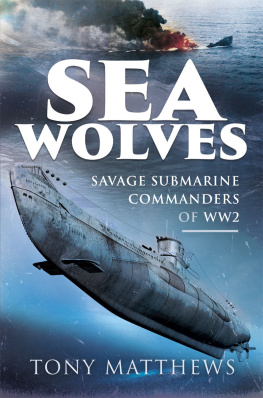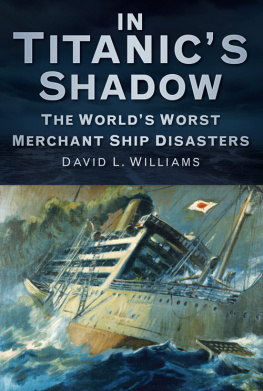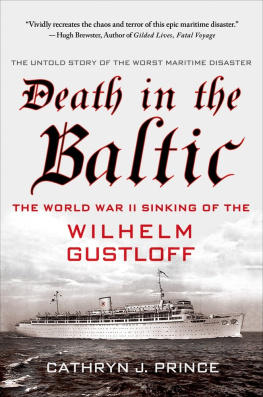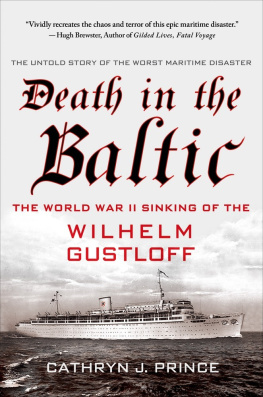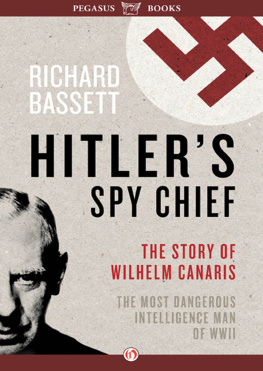SHIP OF FATE
The Story of the MV Wilhelm Gustloff
Roger Moorhouse
Roger Moorhouse 2016
Roger Moorhouse has asserted his rights under the Copyright, Design and Patents Act, 1988, to be identified as the author of this work.
First published 2016 by Endeavour Press Ltd.
For Heinz Schn
(1926-2013)
Table of Contents
Introduction
On 10 November 1943, a Paris cinema was given the dubious honour of hosting the premiere of a major German propaganda film. Titanic was an epic tale of English greed, stubbornness and stupidity on the high seas, which predictably perhaps retold the story of the ships sinking in 1912 as a political morality tale with a blatantly anti-English message.
It had certainly been an ambitious film, with nine huge sets built at the Babelsberg studios in Berlin, as well as a 20-ft replica of the vessel and the requisition of a German luxury liner the Cap Arcona to serve as a stand-in for the doomed ship for high-seas, exterior footage. In addition, propaganda minister Joseph Goebbels had hired one of the rising stars of the German film industry; Herbert Selpin who had scored a success the previous year with the anti-British film Carl Peters to direct. All of this, naturally, came at a cost and Titanic was allocated a record budget of 4 million RM: fully 12 times what some of its rival productions received. Goebbels intention was that his studios would rival Hollywood.
Unsurprisingly perhaps, Titanic endured a difficult production. Rumours of wild parties and illicit liaisons aboard the Cap Arcona , involving the ships crew and young female extras had swirled for months, and had reached the ears of the Propaganda Ministry in Berlin.
Most seriously, however, Goebbels was also displeased with the end-product. The official explanation was that he doubted that the German public had the stomach for a film portrayal of panic and mass death, given they and their loved ones were themselves facing mortal danger. In his diary, he noted merely that the directing was not what it might have been clearly unable to resist taking a posthumous swipe at Selpin and added that he disliked the ending. But it may also be that a more complex motive was at play and that the films implicit message criticising the blind obedience, arrogance and stupidity of the Titanic s crew was deemed too close to home. Whatever the reason, the premiere was to be held in Paris and the film would never be aired in Hitlers Reich.
The audience of German officials, honoured Parisian guests and off-duty soldiers that saw that premiere doubtless enjoyed the film, revelling in the sumptuous visual feast, soaking up the propagandist message. They were entertained, they were thrilled, certainly, but they were also being indoctrinated, just as Goebbels wanted. A few of them might have already suspected that like the ship on the screen before them Hitlers Reich was rushing headlong towards disaster. But, none of them could have imagined that within little over a year, Nazi Germany would have a Titanic of its own.
Ship of Fate
Hitlers real-life Titanic began its life when it slid stern-first down the slipway at the famed Blohm & Voss shipyard in Hamburg, on 5 May 1937. It was to be a vessel whose fate over the following eight years would mirror almost exactly that of the state in which it was born.
It was certainly an impressive sight. Perched on the slipway, towering above a mass of cheering crowds and surrounded by fluttering swastika flags, the ship measured over 200 metres from stem to stern and displaced over 25,000 tonnes, thereby larger and considerably heavier than Hitlers so-called pocket battleships; the Deutschland , the Admiral Scheer and the Graf Spee . It was no battleship, however. It was a cruise liner, one of the largest of the German commercial fleet and the first to be explicitly commissioned by the Nazis for non-military purposes.
The Nazi authorities had assiduously promoted the ship, even before it was launched. Its first rivet had been ceremonially struck a year earlier by the Head of the Reich Labour Front, Robert Ley, and a detailed scale model of the vessel had toured the country to generate public interest and enthusiasm.
Wilhelm Gustloff was, perhaps, a peculiar choice. Somewhat peripheral to Hitlers movement, he was the German-born leader of the Nazi Party in Switzerland, and had since Hitlers rise to power in 1933 expanded the partys activities there, gaining over 5,000 members from among the migr German community and establishing 14 regional branches complete with a Hitler Youth wing. Notwithstanding such efforts, Gustloff would doubtless have languished in obscurity were it not for the fact that he was assassinated in 1936. The circumstances of his death gunned down in cold blood by a Jewish assassin made him very useful to the Nazis for propaganda purposes and so he was proclaimed as a Blutzeuge ; a martyr for the Nazi cause, and given a state funeral in Germany, with Hitler, Gring, Himmler and Ribbentrop all in attendance. In addition, it was decided that the cruise liner then taking shape in Hamburg would bear his name; the most famous vessel in Nazi Germany was to be named after a comparative unknown.
So it was that it was formally christened by its namesakes widow Hedwig Gustloff who, standing alongside Hitler and Ley and dressed theatrically in her widows weeds, delivered her line in a slightly strained voice, before smashing the customary bottle of champagne across the bow. With that, the huge crowd gave a ripple of applause and raised their right arms as one, while the vessel slid slowly back into the choppy waters of the Elbe estuary. The Wilhelm Gustloff was born.
The concept behind the Wilhelm Gustloff was that of state-organised leisure. Taking its cue from the analogous body in Fascist Italy Dopolavoro the Third Reichs leisure organisation was called Kraft durch Freude , (meaning Strength through Joy) and popularly known as the KdF. Established in 1933, as a subdivision of the DAF; the German Labour Front, it had a simple premise. As Nazism itself sought to woo the ordinary German worker away from socialism towards National Socialism, the KdF formed an essential part of the seduction, promising holidays, cultural enrichment and sporting activities as part of the appeal. In essence, it was offering cruises and concerts in place of collective bargaining and class struggle.
Though profoundly political in intent, the KdF was not an entirely cynical exercise. Indeed, it was an expression of the socialist impulse that was part of the Nazi ethos. While Nazism is rightly remembered and reviled for its obsession with Aryan racial purity and its genocidal anti-Semitism, it is often forgotten that its origins lay in an attempt to provide a nationalist narrative with enough socialist content that it would appeal to ordinary Germans. This fusion of ideas is clearly evident in the Nazi Partys early manifesto: the 25 Point Programme of 1920, in which socialist staples such as equality, nationalisation of industry, land reform and the abolition of unearned income were juxtaposed with the more conventional demands of the radical right, such as the exclusion of Jews and the political union of all members of the nation.
This socialist component to Nazisms DNA was certainly diluted in the years that followed; accommodations were made with big business and a cruder realpolitik supplanted some of the early working class populism, but it was never extinguished entirely. Indeed, Adolf Hitler was still declaring his allegiance to what he understood as socialism during the 1932 election:
I am a socialist because it seems to me incomprehensible, to maintain and treat a machine with care but to leave the finest representatives of the labour, the humans themselves, to waste away. Because I want my people to climb up again one day to a high standard of living, I wish for a general increase in its performance, and therefore I stand for the men and women who accomplish these things.
Next page





